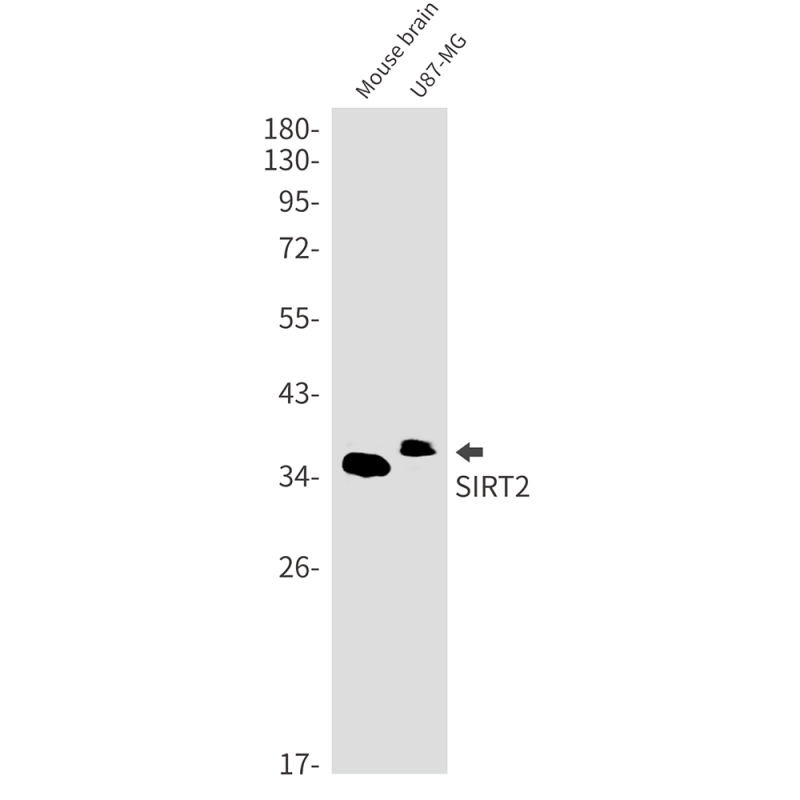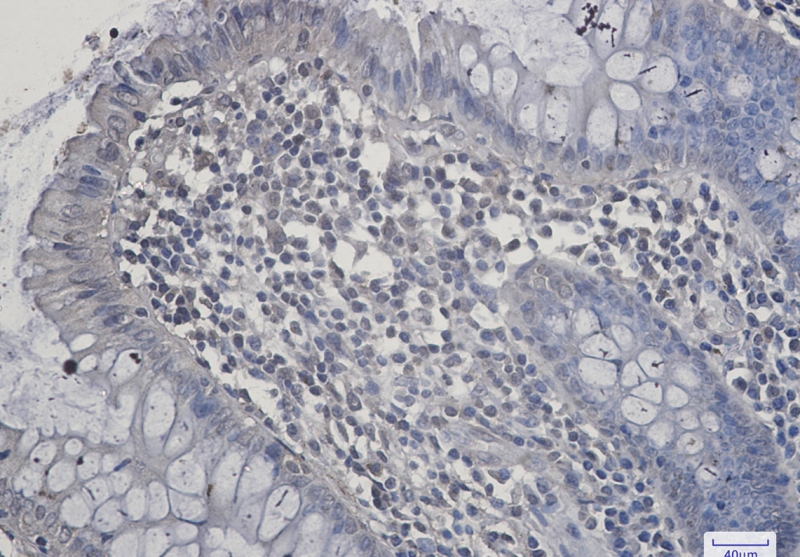


| WB | 1/500-1/1000 | Human,Mouse,Rat |
| IF | 1/20 | Human,Mouse,Rat |
| IHC | 1/50-1/100 | Human,Mouse,Rat |
| ICC | 技术咨询 | Human,Mouse,Rat |
| FCM | 咨询技术 | Human,Mouse,Rat |
| Elisa | 咨询技术 | Human,Mouse,Rat |
| Aliases | SIRT2; SIR2L; SIR2L2; NAD-dependent protein deacetylase sirtuin-2; Regulatory protein SIR2 homolog 2; SIR2-like protein 2 |
| Entrez GeneID | 22933 |
| WB Predicted band size | Calculated MW: 43 kDa; Observed MW: 39 kDa |
| Host/Isotype | Rabbit IgG |
| Antibody Type | Primary antibody |
| Storage | Store at 4°C short term. Aliquot and store at -20°C long term. Avoid freeze/thaw cycles. |
| Species Reactivity | Human,Mouse,Rat |
| Immunogen | Recombinant protein of human SIRT2 |
| Formulation | Purified antibody in TBS with 0.05% sodium azide,0.05%BSA and 50% glycerol. |
+ +
以下是3篇关于SIRT2抗体的参考文献,涵盖其功能研究及抗体应用场景:
1. **文献名称**:*Mammalian Sir2 Homolog SIRT2 Is Required for Chromosome Segregation*
**作者**:North BJ, Verdin E (2003)
**摘要**:该研究利用SIRT2特异性抗体,证实其在有丝分裂中调控染色体分离的功能,通过免疫荧光显示SIRT2与微管蛋白的动态结合。
2. **文献名称**:*SIRT2 Inhibition Confers Neuroprotection by Reducing Neurological Deficits in a Model of Alzheimer’s Disease*
**作者**:Harting K, Krämer A (2007)
**摘要**:通过SIRT2抗体进行免疫共沉淀和Western blot,揭示SIRT2在阿尔茨海默病模型中与微管蛋白的相互作用,抑制SIRT2可减轻神经元损伤。
3. **文献名称**:*SIRT2 Deacetylase Regulates the Activity of Glyceraldehyde-3-phosphate Dehydrogenase in Human Cancer Cells*
**作者**:Hiratsuka M, et al. (2003)
**摘要**:使用SIRT2特异性抗体验证其在癌细胞中的表达,并发现其通过去乙酰化GAPDH调控糖代谢,影响肿瘤细胞增殖。
4. **文献名称**:*Sirtuin 2 Inhibition Improves Cognitive Performance and Acts on Amyloid-β Protein Precursor Processing*
**作者**:Outeiro TF, et al. (2007)
**摘要**:通过抗体验证SIRT2在神经细胞中的表达,发现抑制SIRT2可减少淀粉样蛋白沉积,改善认知功能,提示其作为神经退行性疾病治疗靶点。
这些研究均依赖SIRT2抗体进行蛋白定位、相互作用或表达水平分析,涵盖癌症、神经疾病等领域。
SIRT2. a member of the sirtuin family of NAD+-dependent deacetylases, plays diverse roles in cellular processes such as genome stability, metabolism, aging, and stress response. Primarily localized in the cytoplasm, SIRT2 also shuttles to the nucleus during specific cell cycle phases, regulating chromatin condensation and mitotic exit. It targets substrates including histones (e.g., H3K18. H4K16), tubulin, and metabolic enzymes like PEPCK1. linking its activity to cancer, neurodegeneration, and metabolic disorders. Studies implicate SIRT2 in both promoting and suppressing tumors, depending on context, and its inhibition has shown potential in Alzheimer’s and Parkinson’s disease models by modulating α-synuclein and tau aggregation.
SIRT2 antibodies are essential tools for detecting protein expression, localization, and post-translational modifications. Commonly used in Western blotting, immunofluorescence, and immunoprecipitation, these antibodies must be rigorously validated using knockout controls due to potential cross-reactivity with other sirtuins (e.g., SIRT1. SIRT3). Commercial antibodies often target specific regions, such as the N-terminal catalytic domain or unique peptide sequences, with some distinguishing between isoforms (e.g., the full-length SIRT2 and a shorter splice variant). Applications extend to studying phosphorylation (e.g., at S331) or acetylation-dependent interactions. Researchers should prioritize antibodies with published validation data in their experimental systems to ensure reliability. Host species (rabbit, mouse) and clonality (monoclonal/polyclonal) are selected based on assay compatibility.
×